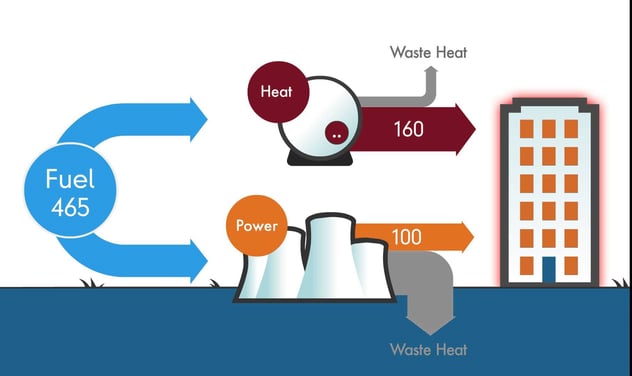What is it?
Combined heat and power is a type of renewable energy technology that you probably haven’t heard a lot about, but this year, you’re bound to see a lot more about it. Combined heat and power, or CHP, integrates the production of usable heat and power (electricity) in one efficient process.
Different to other types of renewable energy technology, CHP can capture any heat that is produced in the process, rather than letting the heat energy go to waste. First and foremost, combined heat and power is an energy efficiency technology which provides a means to substantially reduce fuel consumption without compromising on quality, or the reliability of energy supply to consumers.
By generating heat and power simultaneously, CHP can reduce carbon emissions for a business by up to 30%, as it allows any heat requirements to be met that would normally require additional energy.
For many organisations, CHP is the most effective opportunity to reduce energy costs and to improve environmental performance – existing users are typically saving around 20% of their energy costs.
The benefits
There is no perfect energy source, but CHP is definitely on its way there, especially if heat and electricity is in high demand in your business. Here are the direct benefits of combined heat and power:
- CHP typically has an energy efficiency of over 80%
- Operators can save up to 30% on their carbon emissions
- Increased reliability and flexibility of energy supply
- Energy generated can be easily stored and delivered to meet demand
- Minimum of 10% energy savings.
Alongside the direct benefits that combined heat and power would bring to your business, there are also a range of beneficial outcomes in the long term:
- If the amount that your business is spending on energy is reduced, this can improve the competitiveness of industry and business
- Security of supply being enhanced will make energy go further through more efficient use of fuel
- As CHP is flexible and reliable, it can complement and even enhance other forms of energy generation should your business further its renewable energy investment
- The flexible nature of CHP can be easily stored and later delivered to meet the demand of the user
- Overall reduced demand across the country in regards to centralised power supply, which reduced the stresses on the electricity grid. This is extremely important as the UK’s ageing power stations begin to be decommissioned.
Potential savings for your business
As with all renewable energy technologies, what you’ll be most interested in learning is what an investment in combined heat and power could actually save your business.
Here’s an example calculation for a CHP system running on a renewable woodchip fuel (arborElectroGen45) based on oil fired heating, that illustrates the potential for significant savings:
|
Income - Electric saving |
£38,400 |
|
Income - Renewable electricity subsidy (ROCs) |
£24,192 |
|
Income - Oil saving |
£16,400 |
|
Income - Renewable Heat subsidy |
£49,987 |
|
Cost - Fuel cost |
£38,400 |
|
Cost - maintenance |
£15,000 |
|
Income - Annual net benefit |
£75,579 |
This is based on being able to use 100% of the generated electricity and heat to offset the existing business running costs.
Renewable electricity generated = 320,000 kWh per annum
Renewable heat generated = 656,000 kWh per annum
How Bowler Energy can help…
Bowler Energy are renewable energy specialists, and can take care of the whole process for you, so that you can concentrate your efforts where they’re really needed – your business. From assessing your site for suitability, to the installation and maintenance of a CHP system, Bowler will be there every step of the way.
If you’re interested in learning more about how combined heat and power could help to reduce your energy consumption, and your energy bills, please get in touch with us today.
Photo credit: DECC GovUK




